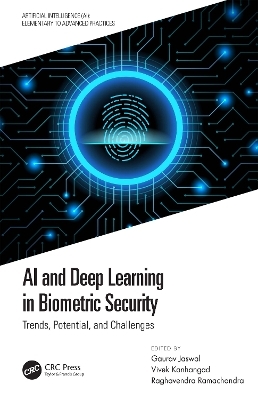
AI and Deep Learning in Biometric Security
CRC Press (Verlag)
978-0-367-67251-5 (ISBN)
This book provides an in-depth overview of artificial intelligence and deep learning approaches with case studies to solve problems associated with biometric security such as authentication, indexing, template protection, spoofing attack detection, ROI detection, gender classification etc.
This text highlights a showcase of cutting-edge research on the use of convolution neural networks, autoencoders, recurrent convolutional neural networks in face, hand, iris, gait, fingerprint, vein, and medical biometric traits. It also provides a step-by-step guide to understanding deep learning concepts for biometrics authentication approaches and presents an analysis of biometric images under various environmental conditions.
This book is sure to catch the attention of scholars, researchers, practitioners, and technology aspirants who are willing to research in the field of AI and biometric security.
Dr. Gaurav Jaswal is currently working as Project Scientist, Electrical Engineering at National Agri-Food Biotechnology Institute Mohali. Prior to this, he was Research Associate, School of Computing and Electrical Engineering, Indian Institute of Technology Mandi, India. He received M.Tech and Ph.D degree in Electrical Engineering from National Institute of Technology Hamirpur in 2018. His research interests are in the areas of multimodal biometrics, biomedical signal processing and deep learning. He regularly reviews papers for various international journals including IEEE Transactions on Information Forensics and Security (TIFS), IEEE Transactions on Biometrics, Behavior, and Identity Science (T-BIOM), IET Biometrics. Dr. Vivek Kanhangad is currently working as Associate Professor, Department of Electrical Engineering, Indian Institute of Technology Indore since Feb, 2012. Prior to this, he was Visiting Assistant Professor, International Institute of Information Technology Bangalore (Jun 2010-Dec 2012). He received Ph.D. from the Hong Kong Polytechnic University in 2010. Prior to joining Hong Kong PolyU, he received M.Tech. degree in Electrical Engineering from Indian Institute of Technology Delhi, in 2006 and worked for Motorola India Electronics Ltd, Bangalore for a while. His research interests are in the overlapping areas of digital signal and image processing, pattern recognition with focus on biometrics and biomedical applications. He regularly reviews papers for various international journals including IEEE Transactions on Information Forensics and Security (TIFS), IEEE Transactions on Cybernetics, IEEE Transactions on Human-Machine Systems and Elsevier journals - Pattern Recognition and Pattern Recognition Letters. Dr. Raghavendra Ramachandra is currently working as a Professor in Department of Information Security and Communication Technology (IIK). He is member of Norwegian Biometrics Laboratory at NTNU Gjøvik. He received B.E (Electronics and Communication) from University of Mysore, India. M.Tech (Digital Electronics and Advance Communication Systems) from Visvesvaraya Technological University, India. Ph.D. (Computer Science with specialization of Pattern Recognition and Image Processing) from the University of Mysore, India and Telcom SudParis, France. His research interest includes Pattern Recognition, Image and video analytics, Biometrics, Human Behaviour Analysis, Video Surviellance, Health Biometrics, and Smartphone Authentication.
1. Deep Learning-Based Hyperspectral Multimodal Biometric Authentication System Using Palmprint and Dorsal Hand Vein. 2. Cancelable Biometrics for Template Protection: Future Directives with Deep Learning. 3. On Training Generative Adversarial Network for Enhancement of Latent Fingerprints. 4. DeepFake Face Video Detection Using Hybrid Deep Residual Networks nad LSTM Architecture. 5. Multi-spectral Short-Wave Infrared Sensors and Convolutional Neural Networks for Biometric Presentation Attack Detection. 6. AI-Based Approach for Person Identification Using ECG Biometric. 7. Cancelable Biometric Systems from Research to Reality: The Road Less Travelled. 8. Gender Classification under Eyeglass Occluded Ocular Region: An Extensive Study Using Multi-spectral Imaging. 9. Investigation of the Fingernail Plate for Biometric Authentication using Deep Neural Networks. 10. Fraud Attack Detection in Remote Verification systems for Non-enrolled Users. 11. Indexing on Biometric Databases. 12. Iris Segmentation in the Wild Using Encoder-Decoder-Based Deep Learning Techniques. 13. PPG-Based Biometric Recognition: Opportunities with Machine and Deep Learning. 14. Current Trends of Machine Learning Techniques in Biometrics and its Applications.
| Erscheinungsdatum | 12.09.2024 |
|---|---|
| Reihe/Serie | Artificial Intelligence AI: Elementary to Advanced Practices |
| Zusatzinfo | 87 Tables, black and white; 90 Line drawings, black and white; 63 Halftones, black and white; 153 Illustrations, black and white |
| Verlagsort | London |
| Sprache | englisch |
| Maße | 156 x 234 mm |
| Gewicht | 698 g |
| Themenwelt | Informatik ► Grafik / Design ► Digitale Bildverarbeitung |
| Technik ► Elektrotechnik / Energietechnik | |
| ISBN-10 | 0-367-67251-0 / 0367672510 |
| ISBN-13 | 978-0-367-67251-5 / 9780367672515 |
| Zustand | Neuware |
| Informationen gemäß Produktsicherheitsverordnung (GPSR) | |
| Haben Sie eine Frage zum Produkt? |
aus dem Bereich


